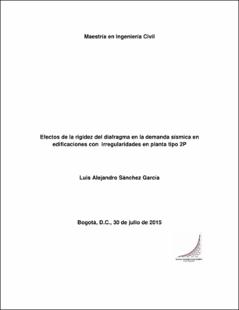Mostrar el registro sencillo del ítem
Efectos de la rigidez del diafragma en la demanda sísmica en edificaciones con irregularidades en planta tipo 2P
| dc.contributor.advisor | Quiroga Saavedra, Pedro Nel, (dir) | spa |
| dc.contributor.advisor | Jerez Barbosa, Sandra Rocio, (dir) | spa |
| dc.contributor.author | Sánchez García, Luis Alejandro | spa |
| dc.date.accessioned | 2015-08-13T21:07:37Z | spa |
| dc.date.accessioned | 2021-10-01T15:41:40Z | |
| dc.date.available | 2015-08-13T21:07:37Z | spa |
| dc.date.available | 2021-10-01T15:41:40Z | |
| dc.date.issued | 2015 | spa |
| dc.identifier.uri | http://catalogo.escuelaing.edu.co/cgi-bin/koha/opac-detail.pl?biblionumber=17774 | spa |
| dc.identifier.uri | https://repositorio.escuelaing.edu.co/handle/001/256 | |
| dc.description.abstract | El Reglamento Colombiano de Construcción Sismo Resistente (NSR-10) (Asociación Colombiana de Ingeniería Sísmica (AIS), 2010) y otras normas internacionales definen metodologías para la distribución de fuerzas sísmicas en edificaciones que consideran la acción del entrepiso (Diafragma) como un cuerpo rígido capaz de transferir las fuerzas inerciales causadas por las cargas horizontales a los elementos verticales que conforman el sistema de resistencia sísmica, de manera proporcional a la rigidez de dichos elementos. Dichas metodologías se basan a su vez en el predominio del primer modo de vibración en la respuesta de la estructura ante un sismo. Este trabajo presenta los resultados de un estudio analítico que busca establecer si la demanda sísmica en el diafragma, definida por las aceleraciones y fuerzas horizontales obtenidas mediante el procedimiento establecido en el Reglamento NSR-10, representa adecuadamente la magnitud y la distribución de la demanda sísmica experimentada por estructuras de concreto reforzado con diferentes tipologías. Se analizó aquí el efecto que genera el grado de irregularidad en planta en dicha demanda para edificaciones de pórticos y muros. Los resultados muestran que si bien en algunos de los casos evaluados el diafragma puede considerarse rígido, como suele hacerse en la práctica, las aceleraciones estimadas utilizando la metodología establecida en NSR-10 pueden estar por debajo de las registradas en análisis dinámicos lineales, lo que implicaría que de seguir esta metodología se diseñarían los diafragmas para fuerzas menores de las esperadas. Por otro lado, se evidencia la necesidad de establecer metodologías o expresiones basadas en las características dinámicas de la estructura y no sólo en la altura y el valor de Sa, como establece actualmente el reglamento NSR-10. | spa |
| dc.description.abstract | The Colombian Seismic Resistance Construction Regulations (NSR-10) (Colombian Association of Seismic Engineering (AIS), 2010) and other international standards define methodologies for the distribution of seismic forces in buildings that consider the action of the mezzanine (Diaphragm) as a body rigid capable of transferring the inertial forces caused by the horizontal loads to the vertical elements that make up the seismic resistance system, proportional to the rigidity of said elements. These methodologies are based in turn on the predominance of the first mode of vibration in the response of the structure to an earthquake. This paper presents the results of an analytical study that seeks to establish if the seismic demand in the diaphragm, defined by the accelerations and horizontal forces obtained through the procedure established in the Regulation NSR-10, adequately represents the magnitude and distribution of the seismic demand Experienced by reinforced concrete structures with different typologies. The effect generated by the degree of irregularity in the plant in said demand for buildings of porches and walls was analyzed. The results show that although in some of the cases evaluated the diaphragm can be considered rigid, as is usually done in practice, the accelerations estimated using the methodology established in NSR-10 may be below those recorded in linear dynamic analyzes, which It would imply that, if this methodology were followed, the diaphragms would be designed for forces lower than those expected. On the other hand, there is evidence of the need to establish methodologies or expressions based on the dynamic characteristics of the structure and not only on the height and value of Sa, as currently established in the NSR-10 regulation. | eng |
| dc.format.mimetype | application/pdf | spa |
| dc.language.iso | spa | spa |
| dc.publisher | Escuela Colombiana de Ingeniería Julio Garavito | spa |
| dc.rights | Derechos Reservados - Escuela Colombiana de Ingeniería Julio Garavito | spa |
| dc.rights.uri | https://creativecommons.org/licenses/by-nc/4.0/ | spa |
| dc.subject | Concreto | spa |
| dc.subject | Estructuras | spa |
| dc.subject | Sismo Resistentes | spa |
| dc.title | Efectos de la rigidez del diafragma en la demanda sísmica en edificaciones con irregularidades en planta tipo 2P | spa |
| dc.type | Trabajo de grado - Maestría | spa |
| dc.type.version | info:eu-repo/semantics/publishedVersion | spa |
| oaire.accessrights | http://purl.org/coar/access_right/c_abf2 | spa |
| oaire.version | http://purl.org/coar/version/c_970fb48d4fbd8a85 | spa |
| dc.description.degreelevel | Maestría | spa |
| dc.description.degreename | Magíster en Ingeniería Civil con Énfasis en Ingeniería de Estructuras | spa |
| dc.publisher.program | Maestría en Ingeniería Civil con énfasis en Ingeniería de Estructuras | spa |
| dc.rights.accessrights | info:eu-repo/semantics/openAccess | spa |
| dc.rights.creativecommons | Atribución-NoComercial 4.0 Internacional (CC BY-NC 4.0) | spa |
| dc.type.coar | http://purl.org/coar/resource_type/c_bdcc | spa |
| dc.type.content | Text | spa |
| dc.type.driver | info:eu-repo/semantics/masterThesis | spa |
| dc.type.redcol | http://purl.org/redcol/resource_type/TM | spa |
| dc.subject.keywords | Concrete | spa |
| dc.subject.keywords | Earthquake Resistant | spa |
| dc.subject.keywords | Structures | spa |
Ficheros en el ítem
Este ítem aparece en la(s) siguiente(s) colección(ones)
-
CF - Trabajos de Grado Maestría en Ingeniería Civil [426]
Trabajos de Grado de la Maestría en Ingeniería Civil de la Escuela Colombiana de Ingeniería Julio Garavito











